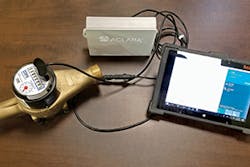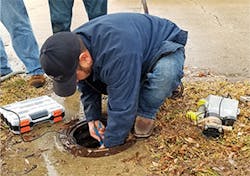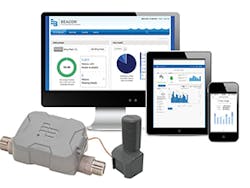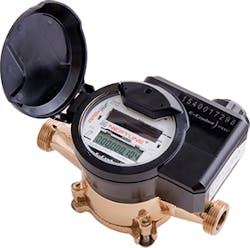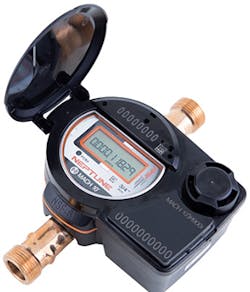Each step along the way from Automatic Meter Reading (AMR) to Automatic Metering Infrastructure (AMI) advanced the technology of meter data collection and management. AMR came first and featured handheld, mobile devices. Next came AMI, incorporating state-of-the-art digital hardware and software. Each advancement improved the technology behind meter data collection and management, explains Brad Johnson, senior product manager for meters at Neptune Technology Group.
Johnson describes the difference between mechanical meters and static meters as dumb versus smart—the former have mechanical parts, the latter do not. Static meters use sound to connect with devices collecting consumption information and are more accurate at measuring low water flows than are mechanical meters.
AMR (automatic meter reading) represented a major step up from the traditional walk-up readings with drive-by radios integrated with meters. Water consumption, identification of leaks and backflows, or lack of water flow could be identified once the data had been downloaded into the utility’s data base.
Next came AMI (advanced metering infrastructure), where, says Johnson, radios send the meter data to a local gateway. This improvement removes both walk-by and drive-by data collection. The gateways, in various locations in the service area, connect to the internet and the data go to the cloud. Just as important, data can now be sent to customers.
The newest technologies are with cellular development which offers communication via a radio frequency or RF network, says Johnson. The data does not have to be sent to a gateway. It can go directly to the cloud through the cellular network. For example, Neptune’s L900 MIU requires no service territory infrastructure and communicates between the meter and the utility via a telecom’s cellular network.
Badger Meter, headquartered in Milwaukee, WI, offers another example of this latest technology. ORION Cellular endpoints use cellular networks to eliminate the need for infrastructure and related maintenance costs and to direct meter data straight to the utility and its customers via its BEACON Advanced Metering Analytics software and EyeOnWater smartphone or tablet application, which offers utility customers hands-on access to their water consumption data.
“Smart meters can monitor themselves, store data, look at water pressure and alarms, and report on what’s happening 24 hours a day,” says Dan Pinney, director of global water marketing at Sensus, headquartered in Raleigh, NC. He adds, “Meters that don’t have electronics systems to record what’s happening and the ability to send back to the utility electronically are not smart meters.”
Graham Symmonds, chief knowledge officer at FATHOM, defines smart meters as bringing time relevance to the use of water. Historically, meters were read every one or two months and the information was always old. Now, smart meters allow customers to have conversations with utilities in real time.
Once a utility begins conversations with its customers, it can give the customer a tool to deal with reducing water use, Symmonds argues. Smart meters offer utilities these tools.
UTILITY FINDS LOST WATER
The 14th Street Spring, as it was known, was a popular sight for as long as people could remember, with a stream of water falling down sandstone rocks in the small town of Monaca, PA, near Pittsburgh.
But only when AMI meters were installed in 2011 and leak detection was implemented did the city discover that it was not a spring, but a major leak draining off 100,000 gallons per day (gpd) from the city’s water wells.
Mario Leone, Jr., the borough manager, says the distribution line that was leaking was probably installed in the 1950s, and when the leak started, water found a crack in the sandstone to escape through. He says the topography of the town is made up of sandstone.
Leone says there was another surprise the water department discovered; it had 2,238 accounts listed, but of the meters ordered, they were short by 191. Accounts had not been purged from the system or meters broken at curb stops couldn’t be turned off. The city has a large renter population, and sometimes renters moving out didn’t ask to have the water shut off. As a result, he says management identified 10% lost revenue. After five years, water accounts now number 2,412.
Monaca signed an energy performance contract with Johnson Controls International for $1.5 million, of which $1.2 million covered the water meters and leak detection equipment. A tax-free bond paid for the project. Leone says projected savings, based on readings of 100 old meters identifying inaccuracies, anticipated a 10% increase in revenues. That and additional newly found revenue would pay down the debt over 15 years. Actual savings exceeded expectations, Leone says.
Johnson Controls International completed all of the project engineering, cost analysis, project management, and equipment procurements. Leone says, “We also did some HVAC, electrical lighting, and building envelope upgrades with the remaining $300,000.”
The first 2,200 meters were replaced with Sensus SR II meters, and new iPerl meters filled out the remaining replacements. Leone says the iPerl meters were just being manufactured and the Borough decided it did not want to wait for them. Both the SR II and iPerl meters work off radio communication, but the iPerl has no moving parts and reads the flow of water in 15-second intervals.
The Borough is only two square miles in size, so one antenna for the whole region was able to pick up all meter readings. The data is transmitted from the antenna back to the utility department, says Leone.
Leone adds, “With being able to get consumption reads daily from the meters, we are able to compare these numbers with the amount of water we produce for the day. Previous to installing the AMI meters, this was done quarterly and the data was not very accurate or useful.”
The old meters ranged in age from 30 to 40 years and required three employees to use hand-held readers and walk the service territory for one month in every quarter. The hand-held readers were not reliable, Leone says.
The new meters greatly improved utility cash flow, Leone says. “Our utility costs in 2011 were $104,000. In 2012, they dropped to $67,112,” says Leone. Contributing to these reduced costs were reductions in the amount of chlorine needed to treat the water. Costs for chlorine dropped from $3,500 to $2,073 when water loss was reduced and leaks were repaired. Other contributors to cost reductions included lower overtime and emergency calls.
Prior to installing the AMI meters, it took about two days to get the final readings when renters moved out of their residences. “Now we can do it in two minutes,” explained Leone. This represents tons of savings in man-hours since meter readers worked in teams of two, he says.
There is some talk of monthly billings, but Leone believes it does not make economic sense, since it would increase administrative staffing. He says they are trying to go to paperless billing. “When we get there, we might consider billing monthly.”
The program was well received by ratepayers, Leone says. “We’re on an older platform of Sensus architecture but will be transitioning to a new system—Sensus Analytics, also known as 'Software-as-a-Service’—when Borough Council is ready to fund the upgrade of our server.” He added that he hopes to bring online a customer portal in 2018 with the new architecture.
SENSUS BUILDS FLEXNEET
Sensus has a full range of commercial and residential smart meters for water utilities (in addition to electricity and gas utilities). They include the SR II and iPERL residential meter and the OMNI commercial meter.
The meters transmit data to and from the utilities via Sensus’ FlexNet Easylink Mobile communications network. The iPerl allows low-flow measurements down to 1 liter per hour.
“We developed FlexNet to connect radios to meters, collect the data and transmit it to the analytics package on the back end (Sensus servers), and give it to the utility,” says Dan Pinney, director of global water marketing at Sensus.
If a utility wants to install AMR meters, they can use FlexNet to get readings more frequently and more flexibly. This is the first step to know what is happening with the customer’s water consumption, says Pinney. Installing an AMI meter, one step up in complexity, will allow the utility to get information as frequently as every 15 minutes, he explains.
Pinney says another advantage of the AMI meter includes being able to detect tampering immediately. Furthermore, it helps capture flow data and pressure data and track non-revenue water loss.
FlexNet EasyLink includes a workbook application with an on-screen map to view routes and status, and a workspace application, a software program that produces customized management reports that integrate with billing systems.
Sensus’ customer base has historically served small towns and rural areas, but it is building a customer base in very large cities, says Pinney. The advantage of the FlexNet system for rural areas is the radio network, which has an extremely long range and can connect meters over varied types of terrain. “We have a meter-wide FCC-licensed radio spectrum,” which allows the utilities to communicate with their customers’ meters wherever they may be located, says Pinney.
IDENTIFYING LOST REVENUE
Benicia, CA, is a bedroom community located about 30 miles east of San Francisco. Christian Di Renzo, assistant director of public works for the city, says many of its upper middle-class residents commute to San Francisco for work.
With a population of approximately 27,000 people, the water utility has 10,000 service connections. It took an aggressive approach to water conservation and sustainability during the California drought by reducing water usage 43% in 2015.
The city began replacing its older residential and commercial walk-by water meters in February 2017 with advanced meter infrastructure and completed the installations the following August. It deployed the Neptune N_SIGHT System, which uses an advanced metering wireless fixed network system.
Di Renzo said the old meters were potentially 30 years old. Before the decision was made to replace the meters, 71 meters were independently tested through the American Water Works Association. The meter with the lowest reading measured 14.6%, and 18 meters read zero for “low flow” (0.25 gallons per minute). Those not recording properly were costing the city $270,000 per year in lost revenue.
The city chose the technology and specified the meter requirements: an AMI meter with real-time reporting, including leak detection, with full metal body and 98.5% accuracy for 20 years, plus a customer portal. It held a symposium with four manufacturers to present the project and chose Neptune Technology Group’s Mach 10 Ultrasonic meter.
The new AMI system has three components. A meter transmission unit is connected to each automated meter and collects a meter reading every hour. Every six hours, it sends the information to one of 26 data collection units (DCU) located throughout the city on city-owned facilities, including poles. These DCUs collect the hourly meter readings and transmit them to the city’s meter reading database.
Benicia’s billing system uses this information to calculate the amount of water used and create bills. Customers are able to access this information through Water Smart’s customer web portal, Di Renzo says.
Di Renzo explains that the department chose to continue its existing relationship with Water Smart’s customer information system because it was more user-friendly, easier to navigate, and tailored toward the customer.
The AMI system can now identify leaks in both customer service lines and the city’s water distribution system, and it will offer alerts through email or text messages to households when it detects either high consumption or continuous water flow.
“What surprised us was how much usage the meters were picking up. They were giving me 98% accuracy. And the reception is almost 100%,” says Di Renzo. For those few meters missed, the department workers simply do walk or drive by to read them.
Another surprise had to do with the position of the antenna receiver jutting out through a traditional meter lid, which posed a potential tripping hazard. Di Renzo says another option would have been to leave the antenna receiver lying in the meter box but he was concerned with reception degradation. Instead he was able to find a manufacturer that made lids with a recessed bore hole designed specifically to accommodate the Neptune receiver so it would sit flush with the lid.
Di Renzo said the department funded the $8 million cost by sending requests for proposals to 11 banks. The city selected Siemens Public’s 15-year loan at 2.57% with an option to prepay after the first year. “We’re hoping to do that,” he says. “The project is on-budget, but I can’t say there is surplus revenue yet.”
Customer reaction to higher bills was complicated, due to an increase in water and sewer rates taking place at the same time—20% for water and 15% for sewer the first year. The first increase came in November 2016, but it wasn’t really felt, Di Renzo says. The second increase came on July 1, 2017, when most of the meters had been installed. “It was a little challenge," in terms of customer reaction, he says. Complaints were predominately about the new rates but they also didn’t believe the readings.
Customer education about the meters was included with rate increase information. Open hours were held weekly in city hall and department representatives were present at farmers markets. Unaccounted for water now captured in revenue was built into the new rate structure, Di Renzo says. On the water side, it seems like revenue is coming in over previous years’ revenue at the current budgeted level, he adds.
UTILITIES CAN ADOPT SLOWLY
Chuck Brunson, director of marketing at Neptune Technology Group, headquartered in Tallassee, AL, says a very large number of utilities still read their meters manually. “Very progressive utilities will adopt the latest technology. It’s the direction everybody’s going,” opines Brunson. “Some utilities are doing a combination of reading their meters and installing AMI technology,” he adds. “We’re trying to help utilities move at their own pace.”
Brad Johnson, senior product engineer at Neptune says the company’s E-Coder is a solid-state encoder register embedded in static or smart meters, providing high-resolution data about water going through the meter. It is also available for mechanical meters and will make them smarter, he says. The E-Coder can register leaks and back flow problems. These problems are at the heart of non-revenue water loss and can also be caused by improper installations or tampering, he says.
Utilities face several major hurdles when they look at updating their meter infrastructure, says Brunson. Upfront costs to replace and maintain their infrastructure and educate their customers are well understood but still challenging. Handling ongoing infrastructure costs can be more complicated. The presence of office servers will usually require IT people to maintain the system. “This is coming to be the latest challenge,” Brunson says.
Funding an upgrade might not be as difficult as first thought. Municipal utilities have options to get funding through bonds. Or they can “pay as they go” says Brunson. A utility may install new meter technology in 20% of its service territory and build up savings before moving to the next phase, Brunson points out. New meters will be more accurate, leaks will be detected, non-revenue water loss will be identified, and backflows repaired. All this will increase revenues, he says.
CEDAR HILL WAS LOSING WATER
“There were a number of issues we were dealing with in 2012. We had significant billing issues, very old infrastructure, and we were losing 40% of our water purchases from Dallas,” reports Joe Komisarz, manager of Cedar Hill Utility Services Department.
Cedar Hill is about 13 miles South-East of Dallas, TX. Incorporated in 1938, it has a population of about 49,650 people and 16,250 meters in its service territory, says Komisarz.
The Cedar Hill leadership ordered a request for proposals and signed a 10-year service contract with FATHOM as an integrator in 2013, Komisarz says.
There are two major pieces to the contract, Komisarz says. The billings have been outsourced to FATHOM via a customer information system with an added customer app. Second, analog meters have been converted to smart meters and are now read by radio, eliminating meter-reading routes. Meters are read every four hours and customers can view their bills every hour if they want, he explains.
Komisarz says, “When customers call and ask why their water bills are so high, we can show them how much water they’ve been using for washing, showering, and irrigating their lawns. It’s been a learning curve both internally and educating customers on how to manage their water use.”
On March 3, 2018, the Utility Services Department held a block party with businesses, he explains. The department set up two computers to show customers how to access their accounts. “A year ago, we set up teenagers in front of laptops demonstrating the customer app with two test accounts FATHOM created to demonstrate customer accounts,” he explains.
“We have another challenge,” says Komisarz. “When you get this innovative system built with data, how do you use it efficiently?” Engineers are interested in peak usage and other data. But there are infrastructure benefits. Better data means better infrastructure planning. When projecting growth and what size pipe is needed for a new development, for example, precise engineering data is available to work with in order to project infrastructure needs.
To determine non-revenue water loss, the department shipped legacy data to FATHOM. For a year, they conducted field audits, surveying 16,339 meter boxes. Of 16,409 accounts reviewed, they identified 2,800 problem accounts involving water theft, unauthorized meter connections, and broken meters, Komisarz says.
New meters were installed starting in December 2014 and were finished by August 2016, Komisarz says. When a meter fails, it fails in favor of the customer. For example, he explains, one woman had not been billed for eight months because of a broken meter.
A sample of 32 meter locations over a six-month period before and after AMI meter installation revealed an average 48% increase in consumption once new meters were installed. Four addresses demonstrated consumption increases from 169% to 284%. By the end of 2016, the department had nearly reached its goal of 10% unbilled and unmetered lost water.
“We’ve had a long-standing relationship with Master Meter. Most of the meters they installed were Master Meter one-inch meters and a small number were Neptune T-10 two-inch meters. They bolted on Neptune electronic registers paired with Aclara two-way radio transmitters to each new meter,” says Komisarz. In all, 16,200 meters were upgraded. “We now get six hours of data transmitted four times a day.”
24 data collection units located around the service territory receive the data and transmit it to FATHOM’s network control center in Phoenix where bills are prepared. The data collection units are pole-mounted and powered by batteries charged by solar panels. FATHOM is also responsible for maintenance and reliability.
Financing the $8.5 million cost of the project was done in three different transactions. “We used some cash on hand and we got a small grant for $300,000. The remainder of the cost was raised with tax-free bonds. We also cut some staff (six full- and part-time positions),” says Komisarz.
“Before the project started, our costs were $6.50 per meter per month. Now they are at $4.49 per meter per month.” The $2.02 per meter per month in savings totals $393,756 per year. “With a payback of 15 years, we think it is feasible to pay off the bond early,” says Komisarz.
“About 20% of our customers are registered and use the web page service tool, including paying bills online. If customers choose to come to the department’s customer service window, staff can answer billing questions and produce printouts of their water usage,” he says.
The portal is already proving useful, reports Komisarz, and in a personal way. Komisarz says he received an alert on his iPhone app and web page that led him to see he had a leak in his home sprinkler system. He had set his alert on a panel on the web page at 6,000 gallons. When it reached 8,000 gallons on day two of his billing cycle, he started looking for leaks. If it had been at day 28, he says he wouldn’t have worried about it.
OUTSOURCING CUSTOMER SERVICES
FATHOM, headquartered in Phoenix, AZ, is a cloud-based software service designed for utilities. It was originally part of Global Water Resources, an investor-owned utility. It left in 2010 to become an independent company providing back-room services to all types of utilities.
FATHOM offers turn-key service for billing, remittance management, analytics, and customer engagement, including installing new meters selected by the utilities. Unlike the other companies featured here, it does not manufacture its own meters.
Graham Symmonds, chief knowledge officer at FATHOM, explains that Global Water Resources was in a high-growth area, buying up utilities, but found they couldn’t connect those utilities to its system. However, they could connect back office systems to operate across large geographic areas.
During the housing boom from 2005 through 2007, the company was adding 800 to 900 home connections a month in growing areas, Symmonds says. The growth stopped in 2008 and hit the hardest in the growing areas. “We went from 100% residence occupancy in service territories to 14% vacancies. One of the ways we sought to compensate was to offer back-office services to other utilities,” he explains.
By 2010 when FATHOM became independent, municipal utilities were also struggling. Because of its efficiencies, FATHOM was able to provide the services at lower costs, thereby saving utilities money. “We use technology to offer turn-key services on per month, per meter fees to mid- to small-scale utilities with 1,000 to 35,000 or 40,000 meters,” Symmonds says.
The service cost works out, on average, to be about $8.00 per meter, per month or less, depending on financing, which could expand the contract cost. The utility can choose what level of service it wants.
“These smaller utilities don’t have the scale to invest in tools to upgrade the segments of their operations that are inefficient when they are manually reading meters once a month, billing 20,000 meters with an old billing system, and managing remittances,” argues Symmonds. “It is an archaic 25-year-old process,” he says. “The utilities don’t have custom portals, no mechanism for handling bad debt. FATHOM allows this function to be modernized including call systems that manage thousands of calls.”
Symmonds says the ability to manage costs are limited if FATHOM is asked to handle manual reads, given that economies of scale are based on automating readings. “Our benefits are based on AMR and AMI meters. Economics are the bottom line,” he says.
For those utilities that need to finance the installation of new meters, Symmonds says FATHOM will bundle financing the installation into the contract, and the company has an option for tax-free financing. Some utilities may have their own funding, he says.
FATHOM’s system is built on top of ESRI’s ArcGIS, its global information system, allowing the company to use the GIS system to access street views and Google maps to photograph every single AMI meter it installs. The AMI meters communicate via a gateway through radio transmitters and receivers FATHOM installs. The gateway sends the readings into its service system in the cloud. The size of the utility and the service territory topology affect the size of the communication network, Symmonds says.
“The utility system may have errors, so we do an audit and may find revenue not being billed,” he explains. “Each of the 56,000 estimated water utilities in the country have their own ways of billing, and it makes it hard [for FATHOM] to understand the billing process at the utility level,” he explains. “But we make sure customers see the integration as a seamless process. It takes a few months,” he says.
Companies offering software-as-a-service has soared, Symmonds says. “We manage about 4.5 million meters, about 5% of the meters in the US, and there are lots of growth opportunities,” he says. “We’ve been able to reduce costs and improve revenue for utilities. Their costs go down as revenues go up. It can feed and maintain revenue and also cover FATHOM’s costs.”
